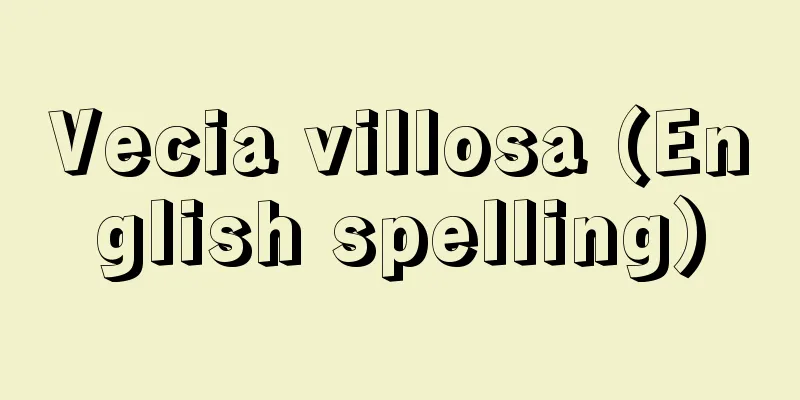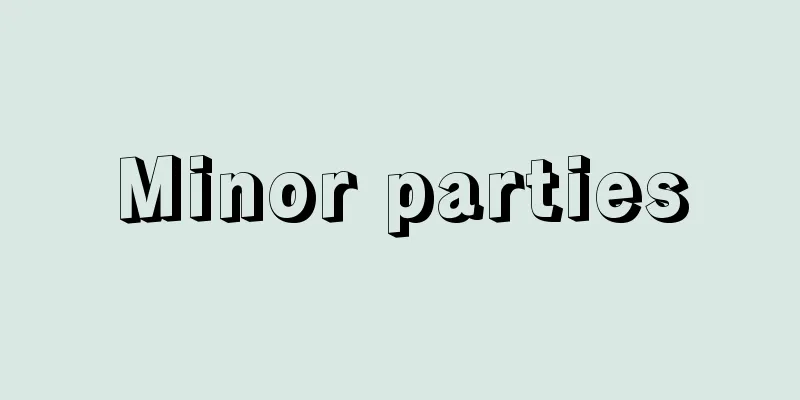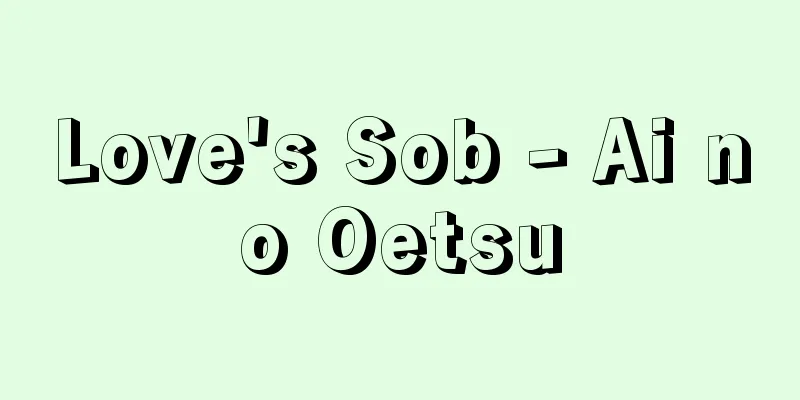History

|
When we say "history," we are referring to some event that happened in the past. But that event no longer exists. There are only written records of it. We try to understand the facts of the past through those records. That is historiography. [Kamiyama Shiro] The Two Meanings of "History"Therefore, the word history has two meanings: res gestae (what happened) and historia rerum gestarum (a description of what happened). In terms of meaning, the German word Geschichte corresponds to the former, and the English word history to the latter. However, these two words are not used differently depending on the content, but rather, both words are used with their two meanings. Rather, this ambiguity is the essence of the word history. The philosopher Hegel said that in order to understand history, one must move from "commemoration" to "reflection." Commemorations of past achievements leave records, but these are not history in themselves. History is created when we consider how to interpret them and the meaning of those records. Indeed, history is a combination of "facts" and "descriptions," and those descriptions are a combination of "records" and "meanings." [Kamiyama Shiro] Fact discovery or construction?The historian Ranke said that historians should only show how the facts were. And to do so, he said that historians should erase themselves and let the facts speak. This was at the beginning of the 19th century, and in contrast to the facts of history that had been used to teach political and moral lessons up until that point, Ranke said that we should look at the facts for their own sake, and to that extent this is a correct attitude for a historian. However, because of this, it is a mistake to think that history is a restoration of past facts, or that facts can be written as they are. Facts are not "things" but "events." "Events" cannot be replicated. Human actions cannot be reproduced exactly as they were in writing. Even when telling the story as it happened, historians do not spend 30 years telling the story of the Thirty Years' War. They only pick out the meaningful things from that story and tell them in a certain context. Moreover, these facts are all interpreted by the historian. There are no raw facts in historical writing; there are only processed facts called interpretations. It is historical documents that tell us where the facts lie, but the documents do not speak for themselves. It is the historian who makes the documents speak. Historians cannot say anything that is not contained in the documents, but historical documents are materials in any case, and the question is how to create an image of the facts from them. Depending on the interpretation, that image will not necessarily be the same. There is not just one historical fact. Furthermore, since historians exist in the present and facts are interpreted and created in the present, it can be said that historical facts exist in the present. Philosopher Croce said that all history is the history of the present. As times change and knowledge changes, facts also change. History can be rewritten. Therefore, history should be called the "construction of facts" rather than the "discovery of facts." Since it is impossible to copy or reproduce facts, discovery theory is impossible. As long as correct inferences are made based on reliable historical materials, construction theory is correct. [Kamiyama Shiro] Historical truthSo how do we know the real facts from information in historical documents? What is the truth of historical fact? There are two logical cases for a statement to be "true". One is a "corresponding truth", which means that if the thing that the statement corresponds to is present in the object, then the statement is true. The other is a "consistent truth", which means that even if there is no object, the statement is true if there is no contradiction and logical consistency between related statements. Since historical facts have few corresponding things, the majority of their descriptions have to be coherent true. For example, the history of ancient Carthage, which was completely destroyed and nothing remains, can be processed as true by the Roman side's information processing. Since coherent truth lies in the rationality of interpretation, there is no truth in historical facts without the ability to think rationally. However, since this is only a logical guarantee, in order to verify the facts, it is necessary to seek as many things that correspond to the statements as possible. This is why the discovery of historical documents and the excavation of artifacts are carried out prior to historical research. However, coherence theory supports constructivism. [Kamiyama Shiro] The Function of Historical PerspectiveWhen historians interpret facts, one piece of knowledge comes into play. That is a historical perspective. A historical perspective is not something that colors blank facts, but is a principle that constitutes the facts themselves. It determines the historian's perspective, and first of all, the differences in each historian's perspective, preconceptions such as preferences, beliefs, and ideologies create a bias in the perspective, and each person constructs the facts differently. However, there are also things that correct this. These are explanatory hypotheses, which are general propositions such as various concepts, definitions, and laws that are used as prerequisites to explain individual facts. These hypotheses are created by various specialized sciences, and historians use them to explain individual facts according to their subject. The explanation will be the same no matter who gives it. This is what we call an objective description of history. History does not create laws, but explains things using laws. If science is not just about creating laws, but also about explaining things using laws, then history is that kind of science. However, it is a science that is parasitic on specialized sciences. This explanatory hypothesis has the function of correcting distortions and biases caused by preconceptions, and therefore strengthens the scientific character of history. And it develops along with the development of specialized sciences. This is why modern historical writing is much more precise than it was 50 or 100 years ago. But what about subtle individual situations and unprecedented facts that cannot be explained by such preconceived notions and general propositions? These are grasped through the re-experiential and sympathetic recognition known as "understanding." Historical facts are more often understood in their mysterious state than explained neatly, so most historical descriptions are comprehension descriptions, but as science progresses, "understanding" is gradually being replaced by "explanation." This is the progress of historical science. [Kamiyama Shiro] History as science and artHowever, the accuracy of explanation is not the only merit of history. It demonstrates facts, but in the pursuit of accuracy, it tends to break down the subject matter more and more. However, on the other hand, historical writing has another task, which is to compile individual facts and present them as a whole. This is an indispensable task in the narration of history. Historical science does not have a specific subject. It can be the politics, economy, legal systems, religion, morality, customs, art, etc. of past events. It can also be a complex matter in which these are intertwined. Historians extract one of these subjects with their own theme, focus on one, and show it as a whole with their own vision. What is the principle that constitutes such a whole picture? It is not a logical inclusion based on a generic concept. It is a concrete inclusion in which a larger scene encompasses a smaller scene. For example, it is like a painter's compositional approach to incorporate an object into a canvas, and it is an intuitive and aesthetic thing that could be called imagination. This is why history is said to be both a science and an art. This is the basic character of history as a humanities science, and its character will not change even in the age of science. In the past, history books were read as rhetoric books, with classical historians such as Herodotus and Tacitus being read as models of fine writing. But while the art of narrative style has faded in the age of science, the art of historical conception still lives on. [Kamiyama Shiro] New HistoryJust as philosophy was once said to be the king of all sciences, history was thought to be the guardian of all of humanity's past. However, advances in knowledge have changed the layout of academic fields. The differentiation of knowledge that comes with progress has also extended to history. The former domain of history has disintegrated, with political history, economic history, legal history, and intellectual history becoming independent. Furthermore, geography, paleography, and archaeology, which were once considered auxiliary sciences of history, have each become independent and become specialized fields in their own right. With this differentiation, the question of what the subject of history proper is is being asked anew. In particular, the development of social sciences has encroached on the domain of history, but history cannot do without the cooperation of social sciences today. The two are intertwined in the form that while social science theorizes the structure and form of society, history writes the history of events that concretely embodies it in reality. However, the principles of historical narrative construction are not found in social sciences. A philosophy or view of history is required. Therefore, even in this scientific age, it is difficult to present a single truth in historical narratives due to differences in the views of history held by historians. However, as coexistence in an international society progresses, common positions are more widely adopted among people, and there is a possibility that a unified narrative will be reached. However, as new knowledge overcomes old knowledge in search of new ways of living in a new society, the possibility of reinterpreting the past and rewriting history is always open to the future. [Kamiyama Shiro] "What is History?" by E.H. Carr, translated by Ikutaro Shimizu (Iwanami Shinsho)" ▽ "The Philosophy of History by W.H. Walsh, translated by Shiro Kamiyama (1978, Sobunsha)" ▽ "History and Truth by A. Schaff, translated by Hiromichi Morioka and Saburo Kido (1973, Kinokuniya Shoten)" [Reference] |Source: Shogakukan Encyclopedia Nipponica About Encyclopedia Nipponica Information | Legend |
|
われわれが「歴史」というとき、それは過去に起こったなにかできごとをさしている。しかしそれはいまはもうない。それについて書いたものがあるだけである。その記述によって過去の事実を知ろうとする。それが歴史学である。 [神山四郎] 「歴史」の二つの意味だから歴史ということばには「起こったこと」res gestaeと「起こったことの記述」historia rerum gestarumという二つの意味がある。語義からいうとドイツ語のGeschichteは前者にあたり、英語のhistoryは後者にあたる。しかしこの二語は内容によって使い分けられているのではなく、どちらも二つの意味をもったまま使われている。むしろその両義性が歴史ということばの本質である。 哲学者ヘーゲルは、歴史をみるのに「記念」から「内省」へ進まなくてはならないといった。過去の偉業の記念が記録を残すが、それがそのまま歴史ではなく、それをどう読むか、その記録の意味を考えるとき歴史ができるというのである。確かに歴史には「事実」と「記述」が、その記述には「記録」と「意味」が重なり合っている。 [神山四郎] 事実の発見か構成か歴史家のランケは、歴史家は事実がどうあったかをただ示すだけだといった。そしてそのために歴史家は自己を消して事実に語らせるべきだといった。これは19世紀の初めに、それまで歴史の事実が政治や道徳の教訓に使われていたのに対して、事実を事実のためにみろといったまでで、その限り歴史家の姿勢としては正しい。 しかしそのことから、歴史を過去の事実の復原だと思ったり、事実をありのままに書けると思うなら間違いである。事実は「もの」ではなく「こと」である。「こと」の模写はできない。人間の行為はそのまま記述に再現できない。あったとおりに語るといっても、歴史家は三十年戦争のことを30年かけて語るわけではない。そのなかで意味のあることだけを取り出し一定の文脈で語る。しかもその事実はみな歴史家によって解釈されている。歴史記述のなかには生(なま)の事実はない。解釈という加工された事実があるだけである。 事実の所在を教えるのは史料だが、史料は自分で語るわけではない。史料に語らせるのは歴史家である。歴史家は史料にないことを語れないが、史料はどのみち材料で、それからどうやって事実のイメージをつくるかである。解釈の違いによってそのイメージはかならずしも同じではない。歴史の事実は一つではない。 また歴史家は現在にいて、事実は現在解釈されてつくられたものだから、歴史の事実は現在にあるといってもいい。哲学者のクローチェは、あらゆる歴史は現在の歴史であるといった。時代が変わり知識が変われば事実も変わる。歴史は書き換えられるのである。 だから歴史は「事実の発見」というより「事実の構成」というべきだろう。事実の模写や再現ができない以上、発見論は無理である。確かな史料に基づき正しい推論がされる限り構成論が正しい。 [神山四郎] 史実の真では、史料の情報からどうやって本当の事実を知るのか。史実の真は何か。言明が「真」であるためには論理的に二つの場合がある。一つは、言明にあたる事物が対象にあるならその言明は真であるという「対応的真」。もう一つは、事物対象がなくても関連する諸言明の間で矛盾がなく論理的整合が得られればその言明は真とされる「整合的真」。歴史の事実は対応する事物が少ないから、その記述は大部分整合的真にならざるをえない。たとえば、破壊し尽くされて何も残っていない古代カルタゴの歴史は、ローマ側の情報処理で真とすることができるように。 このように整合的真は解釈の合理性にあるのだから、合理的思考力のないところに史実の真はない。しかしそれは論理的保証だけだから、事実の実証のためには、言明に対応する事物を求められるだけ求める必要がある。史料の発見と遺物の発掘が歴史研究に先だって行われているのはそのためである。しかし整合論は構成論を支える。 [神山四郎] 歴史観の働き歴史家が事実を解釈するとき、そこには一つの知識が働く。それが歴史観である。歴史観とは白紙の事実に色をつけるようなものではなく、事実そのものを構成する原理である。それは歴史家の見方を決めるもので、まず歴史家めいめいの視点の違い、好みや信条や思想などの先入観が見方に偏りをおこさせ、事実を人によって違ったものに構成させる。 しかしまた、それを是正するものもある。説明仮説というもので、個々の事実を説明するとき前提にするさまざまの概念、定義、法則などの一般命題である。それは各種の専門科学がつくったもので、歴史家は対象に応じてそれらを借りて個々の事実を説明する。その説明はだれがしても同じになる。それが歴史の客観的記述というものである。 歴史学は法則をつくらないが、法則によって説明する。法則をつくるだけが科学ではなく、法則によって説明することも科学だとすれば、歴史学はそういう科学である。しかし専門科学に寄生する科学である。この説明仮説は、先入観によるゆがみや偏りを是正する働きをもっているから、歴史の科学的性格を強めるものである。そしてそれは専門諸科学の発達につれて発達する。50年前、100年前のと比べて現代の歴史記述がずっと精緻(せいち)になったのはそのためである。 しかしそうした既成概念や一般命題から説明できない微妙な個体のありさまや前例のない事実についてはどうするのか。それは「理解」という追体験的・同感的認識によってとらえられる。歴史の事実は、きれいに説明されるより不可解なまま理解されるほうが多いから、大方の歴史記述は理解的記述であるが、それでも科学の進歩につれてしだいに「理解」は「説明」にとってかわられてゆく。それが歴史科学の進歩である。 [神山四郎] 科学と芸術としての歴史しかし説明の正確さだけが歴史学のメリットではない。それは事実の実証をするが、正確さを求めて対象をますます細分化する方向に進む。しかし歴史記述はその半面、個々の事実をまとめて一つの全体として示すもう一つの仕事がある。それは歴史の叙述に欠くことのできないものである。 もともと歴史学には固有の対象はない。過去のできごとの政治、経済、法制、宗教、道徳、慣習、芸術などのどれを対象とすることもできる。またそれらが絡み合う複合的なものをそのまま対象とすることもできる。歴史家は自分のテーマでそのどれかを切り取り、どれかにスポットをあてて、自分のビジョンでそれを一つの全体として示すのである。そういう全体像を構成する原理は何か。それは類概念による論理的包摂とは違う。小さな場面を大きな場面が包む具体的包括である。たとえば、画家が対象をカンバスのなかに取り込む構図の取り方のようなもので、構想力とでもいうべき直観的・美学的なものである。歴史が科学であると同時に芸術であるといわれるのはそのためである。これは人文科学としての歴史学の基本的性格であって、科学時代にもその性格は変わらない。 かつて歴史の本は修辞学の一つとして読まれていた。それはヘロドトスやタキトゥスのような古典史家の著作を名文の手本として読んだのである。しかしそういう叙述の文体の芸術性は科学時代に薄れたが、歴史叙述の構想の芸術性は依然として生きている。 [神山四郎] 新しい歴史学昔は哲学が諸学問の王であるといわれたように、歴史学は人類のあらゆる過去の番人と思われていた。しかし知識の進歩は学問の配置図を変えた。進歩に伴う知識の分化は歴史学のうえにも及んだ。かつての歴史学の領分は分解して、政治史、経済史、法制史、思想史などがそれぞれ独立した。また歴史学の補助科学とされていた地理学、古文書学、考古学などもそれぞれ自立して一つの専門学となった。このような分化につれて、いま歴史学プロパーの対象は何かと改めて問い直されている。とりわけ社会科学の発達は歴史学の領域を侵食したが、歴史学はいまでは社会科学の協力なしにはやっていけない。社会科学が社会の構造や形態を理論化するのに対して、歴史学はそれを現実に具体化する事件史を書くという形で両者はかみ合っている。 しかし歴史叙述の構想の原理は社会科学のなかにはない。そこに一つの哲学または歴史観が要請される。したがってこの科学時代にも、歴史記述は歴史家の歴史観の違いから、ただ一つの事実を示すことはむずかしいが、それでも共存的な国際社会化が進むにつれて人々の間に共通の立場がより広くとられるようになるから、それに伴って斉一な記述に歩み寄る見込みはある。とはいえ、新しい社会に新しい生き方を求めて新しい知識が古い知識を乗り越えてゆくのにつれて、そのつど過去を解釈し直し、歴史が書き換えられる可能性はつねに未来に開かれている。 [神山四郎] 『E・H・カー著、清水幾太郎訳『歴史とは何か』(岩波新書)』▽『W・H・ウォルシュ著、神山四郎訳『歴史哲学』(1978・創文社)』▽『A・シャフ著、森岡弘通・木戸三良訳『歴史と真理』(1973・紀伊國屋書店)』 [参照項目] |出典 小学館 日本大百科全書(ニッポニカ)日本大百科全書(ニッポニカ)について 情報 | 凡例 |
>>: Historical painting - English
Recommend
Kobo Ina - Kugaito
It is also read as "Kugetou". It was a ...
Urdun - Urdun
…Official name = Hashemite Kingdom of Jordan al-M...
accounts receivable
It is recorded in the assets section of the debit ...
Infralittoral zone
…Depending on the tidal action, seven tidal level...
Kyora
…(1) Eight-tone gong: used for the tenth gong. (2...
Shudraka - Śūdraka (English spelling)
Dates of birth and death unknown. An ancient Indi...
Tello, Julio C.
[Born] 1880. Warochiri Died June 4, 1947. Peruvian...
Tomizo Yoshida
Pathologist. Born in Asakawa-machi, Fukushima Pre...
Wofatit
...In this case, a membrane that is resistant to ...
Romany
...Gypsies themselves call themselves rom, roma (...
Entente (English spelling)
A diplomatic term derived from the French entente ...
Muscone
…It is easily soluble in water and alcohol, and i...
Notice - tsuutatsu
〘 noun 〙 (formerly "tsuudatsu") 1. To co...
Tower of Silence
Dakhme-ye Zartoshtiyān : A tower on a rocky mounta...
Chemical potential
When a certain chemical species i (simple substan...









